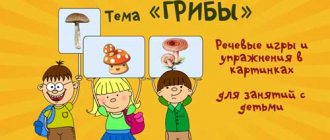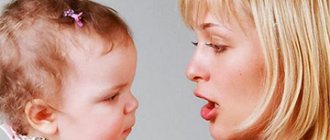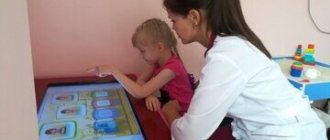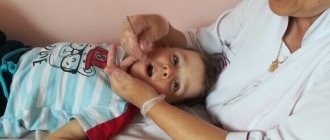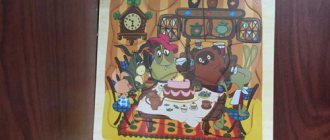Who needs speech therapy sessions?
Nowadays, few people are surprised that schools offer speech therapy classes for children, and there are reasons for this. While the baby goes to kindergarten, to a familiar group where everyone knows him, his loved ones may not notice his speech “defects” (fuzzy sounds, incorrect stress, rearrangement of syllables, distorted sentence construction). At school, the child finds himself in a completely new environment. How will he build relationships in the classroom? Poor diction will interfere with both communication and responding in class. He will begin to feel embarrassed and withdrawn.
Parents of future first-graders, start speech therapy classes with a 6-year-old child, even if he already clearly pronounces all sounds, reads and writes, it won’t hurt.
IMPORTANT!
In addition to difficult social adaptation, speech development disorders result in huge school problems - from poor reading to... failing the Unified State Exam.
Because deviations such as dyslexia (difficulties in reading, misunderstanding of text), dysgraphia (problems with written speech, omissions or rearrangements of letters), dysorthography (understanding of spelling rules, but inability to apply them in writing) catastrophically affect the speed and quality of learning.
If problems with speech or reading are noticeable, the child should be treated by a speech therapist. How to do this in self-isolation? There are free classes with speech therapists on the Internet: specialists conduct master classes for parents or trial lessons online. Undoubtedly, it is better to practice in person, because it is unrealistic to massage the tongue through a monitor. But you can conduct some speech therapy classes with your child at home, more on that later.
IMPORTANT!
A speech therapist is a qualified teacher-defectologist with specific knowledge in the field of medicine (neuropsychology, physiology, neurology, etc.).
Types of activities for speech development
Speech disorders associated with reading and writing appear during the learning process. It is important to recognize them in time and begin to correct them. Let us briefly explain what classes a speech therapist conducts at school and what they are aimed at:
- Correction of sound pronunciation disorders, automation of skills and recognition of sounds in speech and hearing.
- Overcoming speech underdevelopment: developing vocabulary and grammar.
- Development of coherent speech: retellings, stories based on a picture, based on a series of plot paintings.
- Correction of errors in writing: correcting the rearrangement of letters, working out the syllabic structure of a word, developing spelling skills.
When schoolchildren come to their first lesson with a speech therapist, there are no questions about where to start. The teacher gets to know the children, shows exercises that will interest the children (for example, language classes with a speech therapist are very fun). Game-based speech therapy classes for children 6–7 years old who are studying at school are an important component of a teacher’s work. Selecting pictures for classes with a speech therapist is also his task; there are special sets of cards for specific defects.
speech therapists of the highest category.
For what purpose are speech centers opened in secondary schools?
“A speech center is created in a general education institution in order to assist students who have impairments in the development of oral and written speech (of a primary nature) in mastering general education programs (especially in their native language).
Main tasks
speech therapy center are:
— correction of violations in the development of oral and written speech of students;
— timely warning and overcoming difficulties in students’ mastery of general education programs;
— explanation of special knowledge in speech therapy among teachers, parents (legal representatives) of students.”
/Letter of the Ministry of Defense of the Russian Federation dated December 14, 2000. No. 2 “On the organization of the work of a speech therapy center in a general education institution”/.
What is the main task of a speech therapist in a secondary school?
The main task of a speech therapist in a secondary school is to prevent
underachievement caused by various disorders of the development of oral speech.
That is why the speech therapist should pay primary attention to 1st grade students
(children 6-7 years of age) with phonetic-phonemic and general speech underdevelopment. The earlier correctional and developmental training is started, the higher its results will be.
/cm. book: Yastrebova A.V. Overcoming general speech underdevelopment in primary school students at the educational institution. – M.: ARKTI, 1999/.
For how many classes is the logo center open in an educational institution?
In accordance with the Letter of the Ministry of Defense of the Russian Federation dated December 14, 2000. No. 2 “On the organization of the work of a speech therapy center in a general education institution”, a speech therapy center is created in an educational institution if there are 5-10 classes of the first stage of primary education.
First of all, students who have disorders in the development of oral and written speech of a primary nature
, preventing their successful development of general education programs (children with general, phonetic-phonemic and phonemic speech underdevelopment).
What is the maximum capacity of the school logo station?
The maximum occupancy rate for a speech therapy center in a general education institution is no more than 25 people per position.
.
In the event that a speech therapist teacher works with children studying under the Type VII S(K)OU program in special (correctional) classes for children with mental retardation, then the maximum capacity is 15-20 people
.
An increase in the maximum capacity of a speech therapy center will inevitably entail a deterioration in the quality of the educational process and, accordingly, a violation of the rights of children with developmental disabilities to receive an education.
What is the time frame for students to be enrolled in the logo center and groups to be formed?
According to the Letter of the Ministry of Defense of the Russian Federation dated December 14, 2000. No. 2 “On the organization of the work of a speech therapy center in a general education institution”, the selection of children with speech disorders and the formation of groups is carried out from September 1 to 15 and from May 15 to 30 (that is, classes with children are not held on these days). If necessary, a speech therapist teacher can redistribute children into groups and enroll newly arrived students at the educational institution in a speech center throughout the year.
When are students released from the speech therapy center?
Students are released from the speech center throughout the academic year after their impairments in the development of oral and written speech have been eliminated /see. Letter from the RF Ministry of Defense dated December 14, 2000. No. 2 “On the organization of the work of a speech therapy center in a general education institution”/.
How to determine the timing of a child’s training at a speech center?
The duration of correctional education for children depends on the severity of the speech development disorder.
Thus, children with phonetic speech underdevelopment are enrolled in a speech center for a period of 1 to 3 months (if 1-2 sounds are impaired) or up to 6 months (if 1-2 groups of sounds are impaired).
Children with phonetic-phonemic / phonemic / underdevelopment of speech and the resulting impairment of reading and writing study for approximately 4-9 months (from one half year to a whole school year).
Children with general speech underdevelopment (GSD) and related reading and writing impairments are trained at a speech center for 1.5-2 years.
Children of six years of age with special developmental disabilities, children with insufficiently developed means of language (with mental retardation) and the resulting impairment of reading and writing are trained for 2 years.
“What program does a speech therapist work in a secondary school?”
There is no specially developed program for teaching children with oral and written speech disorders in general education schools.
The organization, main content and methods of forming the necessary prerequisites for the productive assimilation of the school curriculum, as well as methods of correctional and developmental education for children with speech impairments, are set out in the Letter of the Ministry of Defense of the Russian Federation dated December 14, 2000. No. 2 “On the organization of the work of a speech therapy center in a general education institution”, in the methodological manual by A.V. Yastrebova “Overcoming general speech underdevelopment in primary school students of educational institutions” (Moscow, 1999).
RMPK Kalininsky Regional Educational Institution and the Methodological Association of Speech Pathologists of the Municipal Educational Institution of the District have developed long-term plans for working with students in grades 1, 2–4 of secondary schools.
“Is it possible to take children to speech therapy classes from classes?”
Correction of pronunciation for students with phonetic defects that do not affect academic performance, as an exception, can be carried out during lessons (except for the Russian language and mathematics) / see. Order of the GlavUO dated December 8, 2000. No. 487 “On approval of approximate provisions on logo points of secondary schools and preschool educational institutions”/.
Classes with other students at the logo center are held outside of school hours, taking into account the operating hours of the educational institution. Students in S(K)K VII type can be invited to the hours of correctional classes (provided for by the curriculum) in agreement with the teacher: with one part of the children the teacher conducts individual and correctional classes, with the other part the speech therapist conducts speech therapy classes.
Who is responsible for mandatory attendance at speech therapist classes?
Responsibility for students' mandatory attendance at classes at the speech center lies with the speech therapist, class teacher and head of the educational institution.
If a student systematically misses classes, the speech therapist should organize work with the family, coordinating his actions with other school teachers (teachers, psychologist, social pedagogue).
Whose responsibilities include monitoring and directing the activities of the school logo center?
Responsibilities for the management and control of the organization and conduct of correctional classes are assigned to deputy directors for educational work (EDW) / see. Instructive letter from the Ministry of Public Education of the RSFSR dated June 30, 1989. No. 17-154-6 “On sending recommendations on individual and group correctional classes with students of special schools and equalization classes for children with mental retardation”/.
The Deputy Director for Educational Resource Management, who has a special education in defectology, also has the right to exercise methodological control and management of the work of the school speech therapy center.
At the request of an educational institution, RMPK specialists provide patronage to the school logo center regarding the identified problem.
Can the school principal temporarily transfer a speech therapist teacher to another job?
It is necessary to be guided by Art. 74 of the Labor Code of the Russian Federation: “In case of production necessity, the employer has the right to transfer the employee for a period of up to one month
for work not stipulated by an employment contract in the same organization
with wages for the work performed, but not lower than the average earnings for the previous job.
Such a transfer is permitted to prevent a catastrophe, industrial accident or eliminate the consequences of a catastrophe, accident or natural disaster; to prevent accidents, downtime (temporary suspension of work for reasons of economic, technological, technical or organizational nature), destruction or damage to property, as well as to replace an absent employee. In this case, the employee cannot be transferred to a job that is contraindicated for him due to health reasons.
The duration of transfer to another job to replace an absent employee cannot exceed one month during a calendar year
(from January 1 to December 31).
With written consent
the employee may be transferred to a job requiring lower qualifications.”
How is the teacher-speech therapist at the OU speech center paid?
A speech therapist is paid at the rate of 20 hours per week. Of these, 2 hours are allocated for completing documentation.
Payment is made for the work of checking students’ notebooks at the speech therapy center.
/cm. Order of the GlavUO dated December 8, 2000. No. 487 “On approval of approximate provisions on logo points of secondary schools and preschool educational institutions”/.
According to clause 6.1.14. “Recommendations on the procedure for calculating wages of employees of educational institutions” (Appendix to the letter of the Ministry of Defense of the Russian Federation and the Trade Union of Workers of Public Education and Science of the Russian Federation dated January 16, 2001 No. 20-58-196/20-5/7) to teachers-speech therapists of speech therapy centers increase the rate wages (official salary) is made by 20%
.
If a speech therapist teacher works in a special (correctional) educational institution (or class, group) for children who, in addition to deviations in speech development, have other deviations in physical development (visual defects, hearing defects, musculoskeletal defects, etc.) or mental deviations development, then the wage rate is increased only for work with children with speech development disorders.
/cm. Instructive letter of the Ministry of General and Professional Education of the Russian Federation dated January 22, 1998. No. 20-58-07IN20-4 “On teachers-speech therapists and educational psychologists in educational institutions”/.
What amount of ethyl alcohol should be allocated to the speech therapist for treating hands and tools?
In accordance with the Instructive Letter of the Ministry of Education of the RSFSR dated January 5, 1977. No. 8-12/25 a teacher-speech therapist at a speech center in a secondary school is allocated 25 grams of ethyl alcohol per child per year (10 school months), that is, 2.5 grams per student per month
.
Article:
One of the characteristics of children who, already in the first grade, go to a speech therapist due to poor performance in basic school subjects, is that educational activities are unformed for various reasons, over which gaming activities predominate.
But due to his age, the child is already at school, and he is faced with the task of mastering the first grade curriculum. Such children, as a rule, are not ready to learn, at least in a school setting, and have low motivation to learn, and often do not want to learn at all. Parents sound the alarm, start doing extra work, the child becomes exhausted and reacts to increased stress by deteriorating health and behavior. Another option for parents to behave is to ignore the problem, as a result of which the child’s academic performance decreases and he completely drops out of the learning process. In the best case, such children, by the end of the first half of the year (when the lack of progress in their studies becomes obvious), end up in the school speech therapist’s office due to problems with writing and reading, although the child does not have a specific speech therapy diagnosis (dysgraphia or dyslexia). In addition, the results in mathematics are the same, that is, they do not meet the requirements of the school curriculum. There are some techniques that help in teaching children for whom, by the time they enter school and in the first grade, play activity predominates as a leading activity. In general, we can say that this is learning in the form of a game, the task of which is to create an information field in which information corresponding to the first grade program will be gradually integrated. Everything should happen smoothly and gradually, so that the child does not have to immediately report for the material covered.
First of all, in classes (individually and in small groups) it is necessary to create an appropriate emotional background - ease, play, that is, in terms of behavior, it is better for a school speech therapist to take the style of a kindergarten teacher as a model. Children and the speech therapist should talk freely with each other, and there should be enough situations for children to move around and laugh.
The next point is to take into account that the child is not sufficiently oriented in the space of the sheet. Requiring a child, for example, to hold a line is ineffective - he is distracted from the main type of work, and the principle of one difficulty is violated. Therefore, it is preferable to use separate sheets of unlined A4 paper rather than a notebook.
Next, the material should be systematized as much as possible, so that in the most general form the child can get a picture of what, in fact, he is studying, and gradually deepen it, without deviating from the main scheme. All work should be built on the same basis, the material should not be presented linearly, but from the general to the specific.
The most important thing is to find a language form accessible to the child in which he can perceive the educational material.
I offer some specific methods and exercises that allow you to achieve dynamics in the development of children in speech therapy classes and help overcome problems in learning to write and read among first-grade students of a comprehensive school.
At the first stage, all learning is built around vowels. During classes, a painted red house is used (on the board and for each child), in which “the hostesses live.” In the future, such a “hostess”-vowel will take its place in the syllable, which for now we will call “apartment”, in the “house”-word. “Apartments” are connected by “bridges” - division into syllables, “guests” AGREE to come to the “hostesses” - these are consonants, and the issue is discussed with the child that the “guest” cannot be alone in the apartment, thus the child learns without memorization that This is the syllabic structure of a word.
The “house” is five floors, the top is triangular (A-Z), below is round (O-E), then a vertical rectangle (U-Y), then a horizontal semicircle (E-E), below is a square (Y-I) . Letters are compared in graphic form (and sounds - in articulation) with their “floors”, “house” is learned by heart with a song: “A-Ya, O-E, U-Yu - I sing a song, E-E, Y-I - run to me." The song is accompanied by a sequential connection of fingers (from thumbs to little fingers), ending with the child “running” his index and middle fingers forward along the table with both hands at the same time. This is how the “red” vowels are learned all together, 10 letters are tied to the graphic image of the house and each corresponds to its own finger, which significantly speeds up and facilitates memorization.
At the same time, consonants are learned (letters-boys in blue and green suits): the speech therapist pronounces the consonant firmly or softly - the child stomps on “hard blue ice,” raising a blue felt-tip pen and pronouncing the corresponding sound. If it’s soft, use a green felt-tip pen, tiptoe along the “soft green grass.” When learning letters, children imitate them, stand up, spin around (for example, E “sticks out his tongue to the sun” - the child turns his head to the left, sticking out his tongue). Letters are learned quickly if colored markers are constantly used in lessons - this way the images of letters are tied to color (corresponding to vowels, hard and soft consonants) and do not merge in perception.
So that in the future the child does not dictate to himself with sounds, to merge into a syllable we chant: “The letter BE, the letter A - together it turned out to be BA” (and so on).
We discuss the connection with the vowels of the second row: “The letters I, E, Yu, E, I have a magic brush with green paint, they turn to the sun and paint the letter that AGREED to stand in front of them green. The letter has been painted, the energy has been spent, and all that remains of the vowels is the “tail.”
Again we sing “house”: A -A-A - I -A-A - tail A-A-A, and so on. Singing the same type of “house” with consonants - this is how the child masters combining consonants with vowels of the first and second row. At this time, children begin to read syllable by syllable, gradually beginning to catch up with their classmates in reading.
Lessons with children who do not yet want to learn are discussed as if they were “helping” the letters to line up correctly with each other. The speech therapist does not assign exercises, but “makes difficult riddles” - the children declare that it is easy for them, they can solve everything - in this way they are included in the lesson and tuned to the result.
Next, learning to write and read goes in two directions: words are practiced (about five in one lesson), starting with short ones (simple syllabic structure) and ending with words with hard and soft signs (softening and division), with conjuncts and vowels of the second row. The children analyze each word in a group as follows: how many red vowels (so many clap-syllables), which consonants “agreed” to appear in each syllable, how many. Some are blue, some are green; the word is slammed syllable by syllable, we “call” the word (we determine the stress), we try how the word will sound with the wrong stress, we discuss that the letters O and E are “sad” without stress (we make sure that they sound in an unstressed position like A and I , respectively) , We discuss this question constantly - why you need to remember with your eyes. The confluence is considered separately: in a syllable we first move in the opposite direction (for example, in the word “table” we first read the second and third letters, then the first, second and third, then add the fourth). It is separately discussed how exactly the vowel of the second row is heard: MYA -A-A - for some reason you can hear A-A-A - the children say (shouting out, overtaking each other) that the letter I “wasted strength”, it softened the letter M , from she only had one “tail” left, otherwise it would have been MA -A-A.
The speech therapist holds each word on a card in front of the children (above eye level), gradually revealing the letters in the right order so that the children can analyze the word, consider all its features, and before starting to write, remember it (“photograph” with their eyes). Then the word is “hidden”, and the children tell in different versions which letter is in what place: before, after, between, penultimate, stressed vowel, unstressed vowels, the number of the place of a particular letter, which letter was not asked about, sometimes separately: which before the first, after the last - there must be answers: “none”, “there is no such letter”. As a result, children do not get stuck within the narrow framework of the task and are included in the process as much as possible. In addition, the option “I wanted to trick you, but it didn’t work out again” and similar statements make children very happy, entertained and allow them to integrate the didactic material of the lesson into the play activities available to them. We look at the word for the last time, discuss the direction of the letters (the letter U “pulls its hand towards the sun”, C - “month”, it “does not make friends with the sun, turns away, warms its back”, etc.) Then we jump, chanting: “ One, two, three, four five - I will write the word (a specific word is called).” The letters in the word are covered with cards of the same color; children write from memory. After such an analysis, mistakes are rare, and besides, the style of working with words extends to the student’s work in the classroom.
The second direction: increasing the sequence of syllables with vowels of the first and second row - this technical point in teaching writing and reading allows you to subsequently avoid losses and rearrangements of consonants and not confuse the vowels of the first and second row. We work according to the scheme of vowels, arranged as in a “house”: in front of the children are notebooks with simple syllables, the child draws a card first with one, then with two consonants (together - three consonants and one vowel), placing them in front of a simple syllable. We read in chorus, starting with the consonant closest to the vowel, then move in the opposite direction (that is, we read the syllable ZDRA : RA , DRA , ZDRA , and so on), “fly over” from the “blue shore” (syllables with vowels of the first row), to “green” (with vowels of the second row). Then the speech therapist reads, the children identify “berezhok” by ear (raise a blue or green felt-tip pen), then put their card with one or two consonants in the right place, read, write down. We are gradually coming to an option where the child listens to a syllable with a complex sequence, with or without softening, without using a notebook at all.
The last link in this scheme is reading, analyzing and writing the sentence. We read in chorus the sentences that are posted on the board. We jump back the number of words in a sentence (so as not to confuse it with slamming a word syllable by syllable). We separately discuss the first capital letter (“It’s so important, it’s CAPITAL for us”) - “entrance”, “door” in a sentence. We negotiate the point (“lock” the sentence). We analyze each “house” word and show with raised fingers which letter is which. Pay attention to the distance between words. There is a sentence diagram on the board with windows for letters - we discuss where we write what, especially unstressed vowels and vowels of the second row. We consider the proposal, remember it, remove it and write it in broken letters according to the diagram. First, the children draw up a diagram, each according to their own model. We first write down the vowels (hold a red felt-tip pen in our hands until all the red windows are filled), then put the emphasis (for this we only need vowels - so that there is no unnecessary confusion), then the soft (green) consonants, and lastly the hard (blue) ones. When signs (black) are added, we write them after the consonants. The syllables, words and sentences in the samples are written in colored letters. Children work with colored markers. The child draws the windows in the size that suits them; constantly moving the markers relieves stress from the hand and makes it easier to switch from one letter to another. Colored letters do not merge in perception; they are more difficult to miss when writing, since their order and number are more noticeable. We begin with block letters and gradually move on to breaking letters in block letters.
During work, the main assessment that children receive is joyful surprise. Not only with words, but also with his voice, facial expressions and gestures, the speech therapist expresses his admiration, sometimes feigns disappointment that “again we failed to outwit anyone, but next time it might work.” This way, children get ready to continue the game next time, are charged with a given emotion, get less tired and come to speech therapy classes with desire and interest, gradually transferring this attitude to their studies as a whole.
